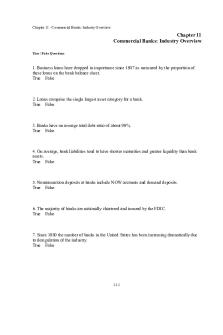Law investments and financial markets chpt 1 notes PDF

| Title | Law investments and financial markets chpt 1 notes |
|---|---|
| Author | Zachary Kok |
| Course | Law of investments and financial markets |
| Institution | Royal Melbourne Institute of Technology |
| Pages | 3 |
| File Size | 92.7 KB |
| File Type | |
| Total Downloads | 40 |
| Total Views | 125 |
Summary
Law investments and financial markets chpt 1 notes...
Description
Law of Investment & Financial Markets Topic 1: Introduction to financial markets in Australia and the regulatory framework Separation of Powers • Legislature (the parliament) makes the law (or change) • Executive (the elected government) administers the law (puts law into action) • Judiciary (the courts) interpret the law (make judgements on the law) Purpose of Law Resolves disputes Maintains the social order Stabilises the economy Helps the disadvantaged Reinforces community values Prevents the misuse of power - doctrine of separation of powers The Rule of Law: The law applies to everybody equally(generally) What is Legislation? Law made by parliaments Legislation is also known as statute law, statues or Acts of parliament What is Common Law? • Law made by judges • Not the same as Civil Law • It operates whenever legislation is either non-existent or imprecise • It includes case precedents AND interpretation of statute Criminal Law: Wrong against society • Prosecuted by the state • Examples: Murder rape & thef • Proof: Beyond reasonable doubt • Remedies: Most serious-punishable by imprisonment Civil Law: Wrongs between individuals • Action brought by one individual against another • Examples: Breach of contract, trespass, negligence • Aim: Compensate the injured party • Burden of proof: Balance of Probabilities • Damages: Monetary compensation awarded for the loss, damage or injury suffered by one person cause by the behaviour of another Legislation vs Court decision Legislation will take priority, unless: • The legislation is struck down by the courts as invalid - The starting point when examining an area of the law is the actual legislation, then look at how the statute has been interpreted by the courts
Why Regulate?(Financial Services Sector) • To maintain confidence in the integrity of the AUS financial system • Transparency • Financial Stability • Investor/consumer protection • Reduction of financial crime Who regulates financial markets in AUS? ASIC (Australian Securities & Investments Commission) ASIC is Australia’s corporate, markets and financial services regulator. Function: The promotion of confident and informed participation by investors and consumers in the financial system. How does it do this: • The Corporations Act 2001(Cth), Chs7 (financial services markets), 6D (fundraising) and 5C (managed investment schemes) • Regulation of Australian companies • Licensing • Disclosure • Regulatory guides+ The laws administered by ASIC are designed to protect: • Consumers • Investors • Creditors APRA (Australian Prudential Regulation Authority) Function: It oversees banks, credit unions, building societies, general insurance and reinsurance companies, life insurance, private health insurance, friendly societies, and most members of the superannuation industry. How does it do this: Enforces prudential standards, relating to: • Capital • Risk management • Accounting • Prudential reporting. ASX (Australian Securities Exchange) Not a governmental regulatory agency What does it do: • A market operator, clearing house and payment systems facilitator • Oversees compliance with its operating rules • Promotes standards of corporate governance among AUS listed companies • Helps to educate retail investors ASX has to cooperate with ASIC in the performance of ASIC’s functions s792D • Providing info about listed companies/notifying ASIC about any breach in rules/C ACT AUSTRAC An AUS Government agency that uses financial intelligence and regulation to disrupt money laundering, terrorism financing and other serious crime.
MEDIA Exposes scandals/ regulatory failures/corporate misconduct etc....
Similar Free PDFs

Financial Institutes and markets
- 7 Pages

Financial Institutions and Markets
- 276 Pages

Financial Markets and Institutions
- 35 Pages

Financial Markets and Institution
- 20 Pages

Money and financial markets 1 .pdf
- 208 Pages

MONEY, BANKING, AND FINANCIAL MARKETS
- 613 Pages

Chpt 4 financial engineering
- 40 Pages

Chap011 - financial markets TB
- 26 Pages
Popular Institutions
- Tinajero National High School - Annex
- Politeknik Caltex Riau
- Yokohama City University
- SGT University
- University of Al-Qadisiyah
- Divine Word College of Vigan
- Techniek College Rotterdam
- Universidade de Santiago
- Universiti Teknologi MARA Cawangan Johor Kampus Pasir Gudang
- Poltekkes Kemenkes Yogyakarta
- Baguio City National High School
- Colegio san marcos
- preparatoria uno
- Centro de Bachillerato Tecnológico Industrial y de Servicios No. 107
- Dalian Maritime University
- Quang Trung Secondary School
- Colegio Tecnológico en Informática
- Corporación Regional de Educación Superior
- Grupo CEDVA
- Dar Al Uloom University
- Centro de Estudios Preuniversitarios de la Universidad Nacional de Ingeniería
- 上智大学
- Aakash International School, Nuna Majara
- San Felipe Neri Catholic School
- Kang Chiao International School - New Taipei City
- Misamis Occidental National High School
- Institución Educativa Escuela Normal Juan Ladrilleros
- Kolehiyo ng Pantukan
- Batanes State College
- Instituto Continental
- Sekolah Menengah Kejuruan Kesehatan Kaltara (Tarakan)
- Colegio de La Inmaculada Concepcion - Cebu







